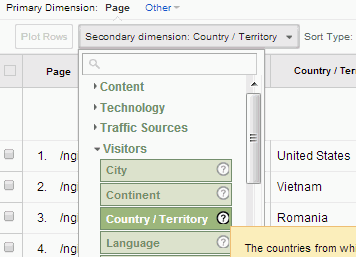Transform Your Analytics Approach With Secondary Dimension in Google Analytics
By incorporating secondary measurements into information analysis, a brand-new layer of insights arises, dropping light on intricate individual actions and communications. The tactical application of second dimensions holds the vital to unlocking a prize trove of very useful info that can change exactly how organizations translate and act upon their information.
Understanding Second Dimensions in Google Analytics
Additional measurements in Google Analytics provide extra context to primary data by allowing individuals to assess metrics across a second measurement, offering much deeper understandings into customer actions and interactions on a site. Secondary Dimension in Google Analytics. While main measurements provide fundamental data factors such as pageviews, bounce price, and session duration, secondary measurements use an even more comprehensive sight by segmenting the key information further. This segmentation allows customers to assess metrics in combination with one more measurement, such as traffic sources, demographics, or individual actions
Advantages of Making Use Of Secondary Dimensions
Utilizing secondary dimensions in Google Analytics provides a strategic advantage by enhancing the depth of analysis and offering a much more detailed understanding of individual communications and habits on a site. By integrating additional dimensions, analysts can acquire important insights into the performance of certain segments or variables within their data. This makes it possible for an extra detailed examination of customer actions past surface-level metrics, permitting a deeper expedition of the variables affecting individual interaction and conversions.

Exactly How to Implement Additional Dimensions
When including additional measurements in Google Analytics, one vital step is to select the pertinent metrics and measurements to improve the evaluation process. To execute second dimensions successfully, beginning by accessing your Google Analytics account and navigating to the report you wish to enhance with additional data. As soon as in the report, find the "Second Dimension" switch, usually discovered over the data table. Clicking this switch will open a drop-down food selection listing numerous dimensions that can be contributed to your primary dimension for much deeper insights.
After picking the appropriate additional dimension, such as 'Source/Medium' or 'Gadget Group,' Google Analytics will present the data in a more in-depth layout, permitting you to cross-analyze different aspects of user habits. Keep in mind to trying out different mixes of key and second dimensions to uncover valuable patterns and trends that can inform your advertising methods. By applying secondary dimensions attentively, you can obtain an extra thorough understanding of your internet site or application efficiency and make data-driven choices to enhance your electronic presence.
Analyzing Data With Second Measurements
Improve your data evaluation in Google Analytics by including secondary dimensions to dig deeper into user actions patterns and enhance your digital advertising and marketing approaches properly - Secondary Dimension in Google Analytics. By adding additional dimensions to your primary information, you can get useful understandings that can aid you make notified choices about your website or application performance
Examining information with additional dimensions permits you to segment your key data additionally, offering an extra extensive sight of individual communications. For example, incorporating the main measurement of 'source/medium' with an additional measurement like 'landing page' can expose which specific web pages are driving traffic from different resources. This info can be crucial in refining your web content approach or enhancing your ad campaign to boost conversions.
Additionally, making use of secondary dimensions allows you to recognize correlations between various metrics, helping you comprehend the effect of numerous factors on Secondary Dimension in Google Analytics user habits. Whether it's assessing demographics alongside user interaction metrics or gadget groups with conversion rates, secondary measurements equip you to uncover hidden fads and patterns that can direct your advertising initiatives.
Maximizing Efficiency With Second Dimensions
To improve the effectiveness of data analysis and decision-making in Google Analytics, incorporating secondary dimensions is key to optimizing performance metrics and gaining deeper insights into user behavior patterns. By utilizing secondary measurements, experts can dive past surface-level information and discover beneficial correlations that may or else go undetected. This optimization approach makes it possible for businesses to tailor their advertising efforts more see this here effectively, determine locations for enhancement in web site functionality, and enhance total customer experience.
Additional dimensions offer an even more detailed view of individual interactions by providing added context to main data metrics. Matching the primary measurement of 'landing web page' with a second measurement like 'device group' can expose whether particular gadgets are more most likely to drive engagement on details touchdown pages. This understanding can inform receptive design enhancements or targeted advertising strategies to improve efficiency.

Final Thought
To conclude, the integration of second measurements in Google Analytics offers companies with an effective device to enhance their analytics approach. Secondary Dimension in Google Analytics. By delving deeper right into customer behavior and communications, marketing professionals can uncover beneficial insights that can drive efficiency optimization and improve the total individual experience. Leveraging second dimensions enables a much more comprehensive evaluation of data, causing more educated decision-making and customized advertising initiatives
Secondary measurements in Google Analytics provide extra context to primary data by permitting individuals to assess metrics across a 2nd measurement, providing much deeper insights into individual actions and interactions on a web site. While primary dimensions supply fundamental data factors such as pageviews, bounce price, and session duration, additional measurements supply a more in-depth sight by segmenting the primary data additionally.One of the vital benefits of making use of secondary dimensions is the capability to reveal relationships and patterns that may not be promptly apparent when evaluating data with main measurements alone.When including second dimensions in Google Analytics, one important step is to pick the relevant metrics and measurements to enrich the evaluation procedure. Combining the key measurement of 'touchdown web page' with a secondary dimension like 'device category' can reveal whether specific gadgets are a lot more most likely to drive involvement on certain touchdown web my company pages.